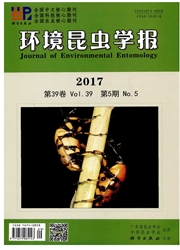

 中文摘要:
中文摘要:
在江西、湖南等南方油茶Camellia oleifera主产区,大分舌蜂Camellia oleifera是传粉效率比较高的一种油茶野生传粉蜜蜂,为进一步开发利用该蜂为油茶授粉提供本底数据资料,并为保护该蜂适生环境及人为构筑巢穴提供可能。2010-2012年历时3年,在江西、湖南等5省共选择13个典型样地进行野外观察和测量,研究该蜂的栖息地环境和访花规律。结果表明:大分舌蜂适宜筑巢的栖息地土壤类型主要以红壤和砂质红壤为主,伴生植物主要有杉木、松树和油茶等,巢穴密集区光照强度在756-1276 lux之间,土壤湿度在25%-30%之间。通过野外观察确认大分舌蜂的蜜源植物为油茶和茶树。该蜂雄性个体到访油茶花主要摄取花蜜补充营养,体表基本不携带花粉且接触柱头的机会比较少,对油茶的授粉作用不大;该蜂雌性个体的访花方式为直接落于花朵雄蕊群正上方,访花敏捷,飞行速度快,为跳跃式访花,在采集花粉的过程中腹部接触柱头,属于典型的腹部触柱式传粉。晴好天气下的不同时间段,大分舌蜂的访花频率、单次访花时间及日活动变化规律存在较大的差异:访花频率在1.05±0.5~4.85±0.4朵/min之间,单次访花时间在12.4±1.04~57.2±4.72 s之间,单株盛花期油茶植株上到访该蜂的数目在4.05±0.56~23.4±2.27头/h之间。
 英文摘要:
英文摘要:
In major production areas of Camellia oleifera, like Jiangxi gigas was among major wild pollinating bees. In order to make it , Hunan Province, the Colletes possible to protect its suitable environment and build man -made nests, during the period from 2010 to 2012, we selected 13 typical sites in Jiangxi, Hunan and other three Provinces for field observation and measurement, study on the habitats and foraging habits of Colletes gigas. The results showed that the soil type of habitat which was suitable for nesting of C. gigas was primary red soil and sandy red soil. Accompanying plants mainly included Cunninghamia lanceolata, Pinus elliottii, C. oleifera and so on. The light intensity in nesting area was between 756 lux to 1276 lux; soil humidity was between 15% to 20% Through field observation and microscrope examination on bee food, we confirmed that the nectar plants for C. gigas was C. oleifera and C. sinensis. The main foraging behavior of male bees was to intake nectar for supplying nutrition. There was little pollen on male body surface, and little probability of contacting with the stigmas. The tripping mode of female bees was landing on androecium directly. The foraging behavior was agile and the speed was high. In the process of foraging, its abdomen touched the stigmas, belonging to the typical Stemotribic. In different periods of a sunny day, there were significant differences on foraging frequency, once foraging time and activity regularity. The foraging frequency was between 1.05 ±0.5 to 4. 85 ±0.4/min, with once foraging time between 12.4 ± 1.04 to 57.2 ±4.72 s, and the number of bees foraging on a flowering tree between 4.05 ± 0.56 to 23.4 ± 2.27/h.
 同期刊论文项目
同期刊论文项目
 同项目期刊论文
同项目期刊论文
 Bees of the Colletes clypearis-group(Hymenoptera:Apoidea: Colletidae) from China with description of
Bees of the Colletes clypearis-group(Hymenoptera:Apoidea: Colletidae) from China with description of A new species of Bathanthidium Mavromoustakis (Hymenoptera: Megachilidae: Anthidiini) from China, wi
A new species of Bathanthidium Mavromoustakis (Hymenoptera: Megachilidae: Anthidiini) from China, wi A review of the Colletes succinctus-group (Hymenoptera: Colletidae) from China with redescription of
A review of the Colletes succinctus-group (Hymenoptera: Colletidae) from China with redescription of Characterization of the Complete Mitochondrion Genome of Diurnal Moth Amata emma (Butler) (Lepidopte
Characterization of the Complete Mitochondrion Genome of Diurnal Moth Amata emma (Butler) (Lepidopte 期刊信息
期刊信息
